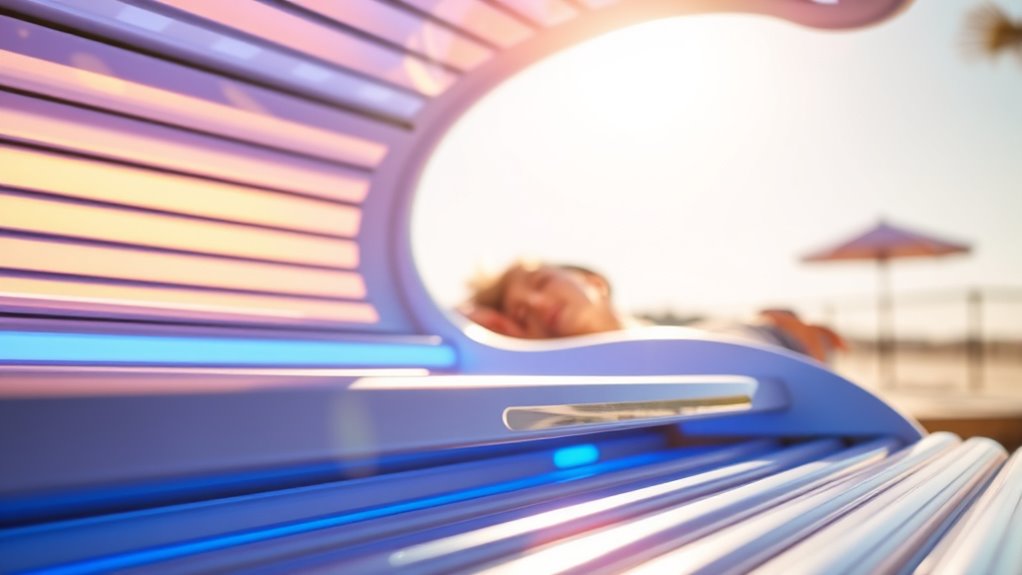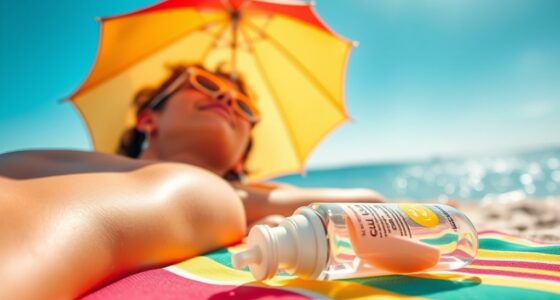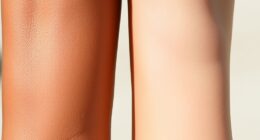It’s a common misconception that tanning beds are safer than sunlight, but they’re actually far more dangerous. Tanning beds deliver intense, concentrated UV rays—both UVA and UVB—quickly damaging your skin and increasing your risk of aging, sunburns, and skin cancer. Unlike natural sun exposure, the damage from tanning beds happens silently and cumulatively over time. Staying informed about these risks can help you protect your skin in the long run. Keep exploring to learn more about why tanning beds are risky.
Key Takeaways
- Tanning beds emit concentrated UV radiation that damages skin similarly to or more than natural sunlight.
- Indoor tanning increases skin cancer risk, including melanoma, regardless of whether it causes immediate redness.
- Tanning beds deliver intense UV doses rapidly, amplifying skin aging and long-term skin health issues.
- Controlled indoor tanning does not eliminate the risks associated with UV exposure; it still causes microscopic skin injuries.
- Using tanning beds is a risky habit that does not provide a safe or healthier alternative to sun exposure.

Many people believe that tanning beds are a safer way to get a tan than exposing your skin to sunlight, but this is a dangerous misconception. Tanning beds emit ultraviolet (UV) radiation just like the sun, and that exposure can lead to significant skin damage. While you might think that controlled indoor tanning reduces risks, it actually increases your chances of harm because the UV doses are often intense and concentrated. Unlike natural sunlight, which varies in intensity and duration, tanning beds deliver a consistent and often high dose of UV radiation, making skin damage more likely with each session.
When you use a tanning bed, you expose your skin to UVA and UVB rays in rapid succession. UVA rays penetrate deep into your skin, causing premature aging, wrinkles, and loss of elasticity. UVB rays, on the other hand, directly damage the outer layers of your skin and are primarily responsible for sunburns. Repeated exposure to these rays accelerates skin damage, and over time, can lead to more serious issues like skin cancer. The misconception that tanning beds are safe often stems from the belief that they don’t cause burns or immediate redness, but the reality is that cumulative UV exposure silently damages your skin, increasing the risk of melanoma and other skin cancers.
Your skin has a limited capacity to repair itself from UV damage. Each time you tan, whether indoors or outdoors, you cause microscopic injuries to your skin cells. These injuries add up over time, weakening your skin’s structure and impairing its ability to fight off harmful agents. This cumulative damage often manifests as uneven skin tone, age spots, and rough patches. The more you tan, the more you compromise your skin’s health, making you more vulnerable to serious conditions later in life.
People tend to underestimate the dangers of tanning beds because they don’t always see immediate effects like sunburn. However, the real danger lies in the long-term consequences of UV exposure. It’s a misconception that indoor tanning is a safe shortcut to a tan. Instead, it’s a risky habit that accelerates skin aging and increases your chances of developing skin cancer. Protecting your skin means avoiding excessive UV exposure altogether, whether from the sun or tanning beds. Your skin’s health and your long-term well-being depend on making smarter choices now.
Frequently Asked Questions
How Do Tanning Beds Compare to Sunlight in Skin Damage?
Tanning beds cause more skin damage than sunlight because they emit concentrated ultraviolet (UV) exposure. Unlike natural sunlight, which varies in UV levels, tanning beds deliver intense UV rays that increase your risk of skin burns, premature aging, and skin cancer. You might think they’re safer, but their concentrated UV radiation damages your skin just as, if not more, than direct sun exposure. Always protect your skin from excessive UV exposure.
Are There Any Safe Tanning Bed Options Available?
Think of safe tanning bed options like a carefully guided tour—there’s no such thing as completely safe, but regulations help. While some alternative tanning methods, like spray tans, pose less risk, strict tanning bed regulations aim to reduce harm. Always choose reputable salons that follow these rules. Remember, no tanning method is entirely risk-free, so consider embracing your natural skin tone instead of seeking a tan.
What Are the Long-Term Health Risks of Tanning Beds?
Using tanning beds increases your risk of skin pigmentation issues and accelerates skin aging. The UV radiation damages your skin cells, leading to wrinkles, age spots, and loss of elasticity over time. Long-term, it also raises your chances of developing skin cancer, including melanoma. Even if you think you’re avoiding sunlight, tanning beds still expose you to harmful UV rays, so it’s best to steer clear for healthier skin.
Can Tanning Beds Help Prevent Vitamin D Deficiency?
Like a delicate dance with the sun, using tanning beds for vitamin D synthesis might seem tempting. However, they aren’t a safe or effective way to prevent vitamin D deficiency, as they can harm your skin health. Your skin needs natural sunlight in moderation, and it’s better to get vitamin D through diet or supplements. Relying on tanning beds puts you at unnecessary risk without providing reliable health benefits.
Do Tanning Beds Emit Harmful UV Radiation Similar to the Sun?
Tanning beds emit UV radiation that’s similar to the sun, exposing you to harmful UV exposure. This radiation can damage your skin cells and increase your risk of skin carcinogens, including skin cancer. Even though some think tanning beds are safer, they still pose significant health risks. It’s better to seek safe ways to get vitamin D without risking your health from UV exposure and skin damage.
Conclusion
Don’t be fooled into thinking tanning beds are a safer alternative to sunlight—they’re just as dangerous, if not more. Like wolves in sheep’s clothing, they hide risks behind false promises of safety. Remember, both expose you to harmful UV rays that can damage your skin and increase cancer risk. Protect your health by avoiding tanning beds and sunbathing. Your skin’s health is a delicate garden; don’t let false safety measures become weeds choking it away.









